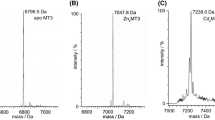Abstract
The synthetic peptide fragment containing residues 49–61 of rabbit liver metallothionein II (MT-II) (Ac-Ile-Cys-Lys-Gly-Ala-Ser-Asp-Lys-Cys-Ser-Cys-Cys-Ala-COOH), which includes the only sequential four cysteines bound to the same metal ion in Cd7MT, forms a stable, monomeric Cd-peptide complex with 1 : 1 stoichiometry (Cd:peptide) via Cd-thiolate interactions. This represents the first synthesis of a single metal-binding site of MT independent of the domains. The 111Cd NMR chemical shift at 716 ppm indicates that the 111Cd2+ in the metal site is terminally coordinated to four side-chain thiolates of the cysteine residues. The pH of half dissociation for this Cd-peptide derivative, ∼3.3, demonstrates an affinity similar to that for Cd7MT. Molecular mechanics calculations show that the thermodynamically most stable folding for this isolated Cd2+ center has the same counterclockwise chirality (Λ or S) observed in the native holo-protein. These properties are consistent with its proposed role as a nucleation center for cadmium-induced protein folding. However, the kinetic reactivity of the CdS4 structure toward 5,5′-dithiobis(5-nitrobenzoate) (DTNB) and EDTA is greatly increased compared to the complete cluster (α-domain or holo-protein). The rate law for the reaction with DTNB is rate=(k uf +k 1,f +k 2,f [DTNB])[peptide], where k uf=0.15 s–1, k 1,f=2.59×10–3 s–1, and k 2,f=0.88 M–1 s–1. The ultrafast step (uf), observable only by stopped-flow measurement, is unprecedented for mammalian (M7MT) and crustacean (M6MT) holo-proteins or the isolated domains. The accommodation of other metal ions by the peptide indicates a rich coordination chemistry, including stoichiometries of M-peptide for Hg2+, Cd2+, and Zn2+, M2-peptide for Hg2+ and Au+, and (Et3PAu)2-peptide.
Similar content being viewed by others
Author information
Authors and Affiliations
Additional information
Received: 9 December 1998 / Accepted: 20 May 1999
Rights and permissions
About this article
Cite this article
Muñoz, A., Laib, F., Petering, D. et al. Characterization of the cadmium complex of peptide 49–61: a putative nucleation center for cadmium-induced folding in rabbit liver metallothionein IIA. JBIC 4, 495–507 (1999). https://doi.org/10.1007/s007750050335
Issue Date:
DOI: https://doi.org/10.1007/s007750050335




